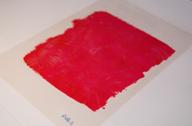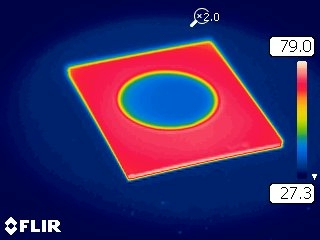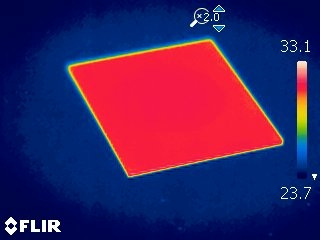Contact: Dr Andreas Schueler, Anna Krammer
Solar thermal collectors are more and more used as a source of renewable energy for domestic hot water production and space heating. A common problem with such systems is overheating and the resulting stagnation of the collector. During stagnation, high temperatures lead to water evaporation, glycol degradation, and stresses in the collector with increasing pressure. Special precautions are necessary to release this pressure; only mechanical solutions exist nowadays. Additionally, the occurring elevated temperatures lead to degradation of the materials the solar collector is made of. This concerns seals, insulation materials, and also the black selective coating on the solar absorber.
Thermochromic materials could be a promising way to avoid overheating of solar thermal collectors.
Optical switching of materials can be obtained by organic and inorganic materials. An example for a thermochromic organic paint is shown in Fig.1.



Fig. 1: Thermochromic transition of an organic paint which changes its colour from red to white at a transition temperature of 35°C. The transition can be induced by simply warming up the sample with one’s hands.
Preliminary studies have shown that the durability of organic thermochromic compounds might however not be sufficient for glazed metallic collectors. For this reason, novel inorganic, durable thermochromic coatings are being developed at LESO-PB (see Fig. 2). These coatings are deposited using several processes such as sol-gel coating, reactive evaporation and reactive magnetron sputtering.
Several experimental methods are used to characterize the physical properties of these thermochromic coatings, which exhibit a complex electronic structure. Spectroscopic ellipsometry is a highly accurate method for determining the temperature-dependent dielectric function of the thermochromic coatings during the reversible transition from the semiconducting to the metallic phase. The size of the nanocrystals in the nanocomposite texture of the films is measured by X-ray diffraction (XRD), while the chemical composition can be inferred from Rutherford backscattering (RBS) or electron microprobe analysis (EPMA). The information coming from the various complementary techniques helps us to understand the fascinating physics of these novel thermochromic solar coatings.


Fig. 2: Infrared imaging of the thermochromic behaviour of an inorganic thin film. Above the transition temperature, the film shows metallic behaviour and is opaque (image on the left). Below the transition temperature, the film is semiconducting and therefore IR – transparent (image on the right).
PhD Thesis
Switchable Selective Absorber Coatings for Overheating Protection of Solar Thermal Collectors. Thèse EPFL, n° 5878 (2013)
Publications in this domain:
Influence of doping in thermochromic V1−xWxO2 and V1−xAlxO2 thin films: Twice improved doping efficiency in V1−xWxO2, in Journal of Alloys and Compounds, vol. 621, p. 206-211, 2015.
Temperature-dependent multiangle FTIR NIR-MIR ellipsometry of thermochromic VO2 and V1-xWxO2 films, in Solar Energy, vol. 118, p. 107-116, 2015.
Thermal solar collector with VO2 absorber coating and V1-xWxO2 thermochromic glazing – Temperature matching and triggering, in Solar Energy, vol. 110, p. 151–159, 2014.